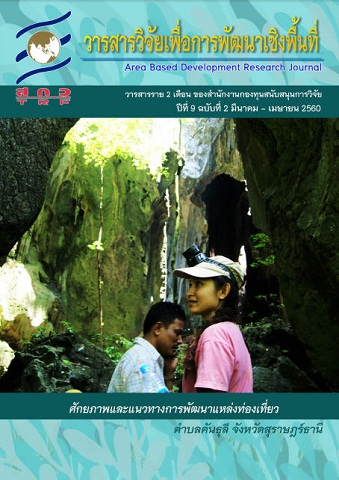ศักยภาพและแนวทางการพัฒนาแหล่งท่องเที่ยวตำบลคันธุลี จังหวัดสุราษฎร์ธานี
Main Article Content
Abstract
งานวิจัยนี้มีวัตถุประสงค์เพื่อจำแนกช่วงชั้นโอกาสด้านนันทนาการ ประเมินศักยภาพทรัพยากรท่องเที่ยวและจัดทำแนวทางพัฒนาการท่องเที่ยว ตำบลคันธุลี อำเภอท่าชนะ จังหวัดสุราษฎร์ธานี ด้วยการวิจัยเชิงปฏิบัติการแบบมีส่วนร่วมโดยวิธีการสัมภาษณ์เชิงลึก สำรวจภาคสนาม สังเกตแบบมีส่วนร่วม และวิเคราะห์ SWOT เครื่องมือเก็บรวบรวมข้อมูล ประกอบด้วย แบบจำแนกช่วงชั้นโอกาสด้านนันทนาการ แบบประเมินศักยภาพทรัพยากรท่องเที่ยวและแบบสัมภาษณ์ วิเคราะห์ผลโดยการวิเคราะห์เนื้อหา และประมวลผลโดยการวิเคราะห์เชิงพรรณนา ผลการศึกษาด้านความต้องการของชุมชนต่อการพัฒนาแหล่งท่องเที่ยว พบว่าส่วนใหญ่ต้องการการบริหารจัดการร่วมกันระหว่างองค์การบริหารส่วนตำบลคันธุลี (ร้อยละ 57) ชุมชน (ร้อยละ 27) และกลุ่มอนุรักษ์คันธุลี (ร้อยละ 16) ผลการจำแนกช่วงชั้นโอกาสด้านนันทนาการ พบว่า ถ้ำรอยพระพุทธบาท ถ้ำลึก ถ้ำตาจิตร และถ้ำไทรทอง เป็นแหล่งนันทนาการประเภทธรรมชาติกึ่งสันโดษไม่ใช้ยานยนต์ (ค่าเฉลี่ย = 3.89, 3.64, 3.90 และ 3.95 ตามลำดับ) ขณะที่ถ้ำค้างคาวเป็นประเภทธรรมชาติสันโดษ (ค่าเฉลี่ย = 4.47) และเส้นทางศึกษาธรรมชาติป่าพรุเป็นประเภทธรรมชาติกึ่งสันโดษใช้ยานยนต์ (ค่าเฉลี่ย = 3.37) ด้านศักยภาพ พบว่าแหล่งท่องเที่ยวประเภทถ้ำ (ถ้ำรอยพระพุทธบาท ถ้ำลึก ถ้ำตาจิตรและถ้ำไทรทอง) มีศักยภาพระดับดี (ค่าคะแนน = 77, 77, 81 และ 78 ตามลำดับ) และป่าพรุคันธุลี มีศักยภาพระดับปานกลาง (ค่าเฉลี่ย = 1.93) แนวทางการพัฒนาแหล่งท่องเที่ยว ประกอบด้วย 5 แผนงาน (18 โครงการ) ดังนี้1) การพัฒนาปรับปรุงด้านกายภาพของแหล่งท่องเที่ยวและเส้นทางท่องเที่ยวและโครงสร้างพื้นฐาน 2) การพัฒนาศักยภาพบุคลากรและชุมชนในระบบการท่องเที่ยว 3) การเฝ้าระวังและรักษาทรัพยากรและสิ่งแวดล้อม 4) การเผยแพร่ประชาสัมพันธ์และสื่อความหมายสำหรับการท่องเที่ยว และ 5) การพัฒนาระบบการบริหารจัดการการท่องเที่ยวแบบโครงข่าย ปัจจัยความสำเร็จ คือ กลุ่มคนที่มีศักยภาพร่วมบริหารจัดการ องค์กรที่ให้การสนับสนุนอย่างจริงจัง การสนับสนุนของฝ่ายวิชาการ และการพัฒนาโครงข่ายการท่องเที่ยว
Potential and Guidelines for Tourism Development in Khanthuli Sub-district, Suratthani Province
The objectives of this research were to classify recreation opportunity, evaluate potential of tourism resources and initiate guidelines for tourism development in Khanthuli sub-district, Suratthani province. It was participatory action research. Data was collected by using in-depth interview, survey, observation and SWOT analysis. The instruments used for this research were an application of recreation opportunity spectrum (ROS), an evaluation of cave attraction potential and interview questionnaire form. Descriptive content analysis and evaluation were used to determine the result of the study. The result revealed that the majority of the community agreed to participate in administrating tourist attractions with Khanthuli sub-district Administration Organization (57%), community (27%) and Khanthuli Conservation Group (16%). The result of the ROS demonstrated that Roi Phraphutthabath cave, Lueak cave, Ta Chit cave and Thai Thong cave were semi-primitive non-motorized (mean = 3.89, 3.64, 3.90 and 3.95, respectively), Khang Kao cave was primitive (mean = 4.47), and the swamp forest trail was semi-primitive motorized (mean = 3.37). Result from the potential evaluation indicated that the cave attractions (Roi Phraphutthabath cave, Lueak cave, Ta Chit cave and Thai Thong cave) had significant potential (score of 77, 77, 81 and 78, respectively) and Khanthuli swamp forest had moderate potential (mean = 1.93). In addition, the tourism development plan consisted of 5 plans (18 projects) as follows: 1) landscape and infrastructure development plan 2) human resources development plan 3) environmental protection plan 4) public relation plan and 5) tourism looping management plan. The essential elements for success were participations among potential people, supporting organizations and tourism network development.
Article Details
Area Based Development Research Journal values copyright protection and licensing to safeguard author rights and facilitate the appropriate dissemination of research. Our policies ensure openness, accessibility, and attribution. Authors retain copyright ownership, and articles are published under a Creative Commons Attribution License (CC BY), allowing sharing, adaptation, and proper attribution. Authors have the freedom to publish under the CC BY license, granting broad reuse and distribution permissions. The journal supports posting articles on third-party repositories, adhering to institutional and funding restrictions. Author guidelines detail copyright and licensing requirements, empowering authors with knowledge about their rights and responsibilities. These policies cultivate an environment of collaboration, openness, and responsible sharing, benefiting authors and the research community while honoring intellectual property rights.


